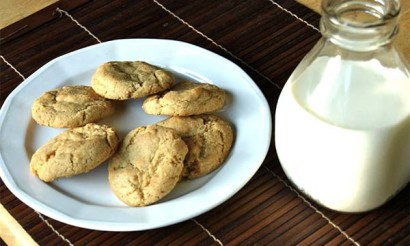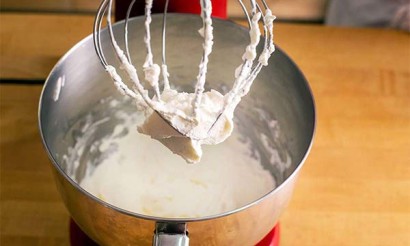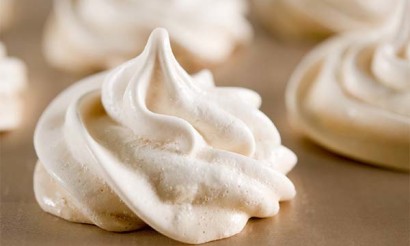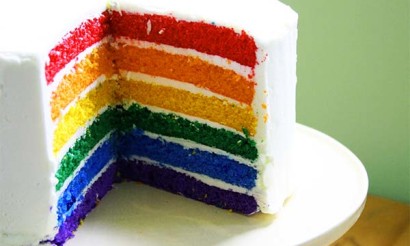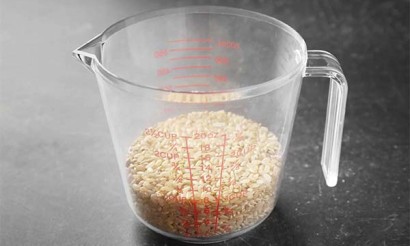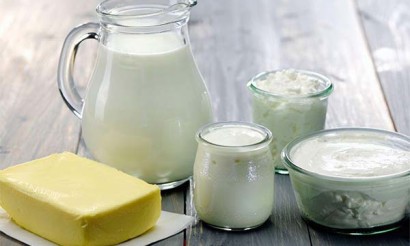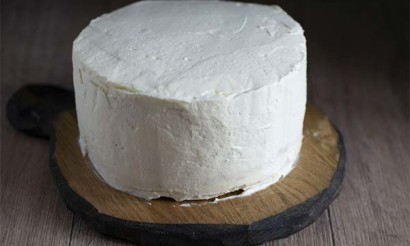How to check the quality of butter
This product is consumed by almost everyone, but not everyone knows how to choose high-quality butter.
- What is butter?
- Product Benefits
- Its use in folk medicine
- Butter types
- Main signs of real butter
- GOST or TU
- Fat content
- Color
- Smell
- Composition
- Price
- Shelf life
- Packaging
- Proper Butter Storage
- Real Butter: Hard or Soft
- How to identify palm oil in butter
- How to distinguish butter from margarine and spread
- How to Tell the Quality of Butter at Home
- By packaging
- Texture
- In a pan
- By slice
- By freezer
- By taste
- By knife
- With hot water
- With manganese dioxide
- How to choose a quality butter in a store
- How to Make Butter at Home
What is Butter
Butter is a concentrated product of milk fat obtained by separating the cream of cow's milk. To make 1 kg of butter, it takes 25 liters of raw milk.
Product Advantage
The unique nutritional value of butter is due to its almost 100% digestibility and the content of a number of vitamins.
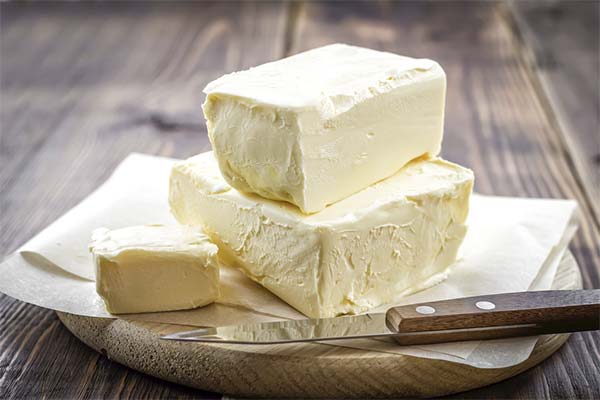
- It contains vitamin A, which is essential for strengthening the immune system and supporting eyesight.
- In addition, dairy fats help the absorption of vitamins B, E and D.
- Vitamin K is very useful for pregnant women or those who are just planning to conceive.
Butter is an essential product in dietary and children's diets, despite its high caloric content (on average 755 kcal per 100 grams). It contains about 140 fatty acids, which cannot be obtained from plant foods. Including those such as omega-3 and omega-6, which the human body is not able to produce on its own. These acids are necessary for normal brain function, bone health and circulatory system function. The oleic acid contained in the creamy product contributes to the prevention of cancer.
Unsaturated fats in butter keep the heart muscle and blood vessels toned. For example, butter is an important source of lecithin, which helps to clear cholesterol from blood vessels. The product contains a whole complex of macro- (calcium, magnesium, sodium, potassium and phosphorus) and micronutrients (iron, zinc, copper, manganese). They slow the aging process of skin cells, improve mood, memory, attention, and normalize metabolism.
Regular use in the morning a couple of sandwiches with quality butter or adding a piece to freshly cooked porridge will have a beneficial effect on the beauty of the skin, nails, hair, adjust the digestive tract, increase endurance and stress resistance.
The norm of safe amount of butter is about 10-20 grams per day. Excessive consumption of butter, including its use for frying, will have adverse effects, such as obesity, increasing the fat content of the skin and blood cholesterol levels, digestive problems, malfunction of the thyroid gland, liver, gall bladder.
Introducing butter into the children's menu is possible from the age of five months, starting with 1-4 grams. It is best mixed at first with vegetable or fruit complementary foods, then move on to porridge with butter. Gradually increasing the rate should be brought to 15 g daily when the child is three years old.
Hypoglycemic index of butter is very high, so it should be used with great caution to people with diabetes. The norm allowed by dietitians in this case is no more than 10 g per day.
Allergies to butter are quite rare, more often the complications are caused by the additives contained in the composition - emulsifiers, stabilizers and others. Allergy sufferers should study the contents of the label very carefully.
During pregnancy, the burden on the woman's body increases. Increasing the norm of this creamy product to 30 grams will only benefit you.
Butter is allowed for various gastrointestinal diseases, particularly for gastritis, pancreatitis, cholecystitis. A moderate amount of butter eaten will not harm the patient, but will improve the passage and absorption of food. However, with exacerbations, you should temporarily give up butter and other types of oil. Regular use of the product will help to cope with the problem of constipation.
Women will be interested to know that butter is actively used in cosmetology. It effectively fights dry skin, premature wrinkles. Applying the oil to small wounds will help speed up their healing. Rubbing the area under the eyes with a piece of cold butter will help relieve tension and saturate with nutrients. Using the milk product in masks for hair will give them silky and elastic.
Folk Medicine Applications
Butter finds use in folk medicine.
- It is used to lubricate the gums of children who are teething to relieve pain.
- If you have a painful dry cough, it is recommended to eat the oil with sugar.
- Such a recipe also acts as a diuretic, removing excess water from the body.
- It is useful to smear the oil rash with hives.
- A mixture of boiled chicken yolk and butter applied to a small burn will help rapid healing without scarring.
- In case of diarrhea, it is recommended to add a little oil to wine and drink this mixture.
- Lemon and garlic oils are especially useful for strengthening the immune system in the autumn-winter period. For the first one, mix the juice of half a lemon with 150 grams of oil and salt. For garlic oil, mix 150 grams of oil and a couple of garlic cloves. It is recommended to consume one teaspoon a day.
Even a simple sandwich with butter in the cold season will energize and warm you up. This breakfast is especially important for schoolchildren and working people. Melted butter is used to treat joint and lower back pain.
Types of butter
The range of butter varies depending on the chemical composition or methods of production.
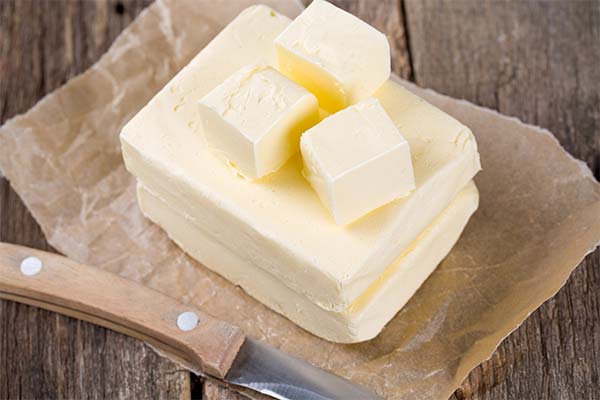
At the factory, the cream is pasteurized, that is, the pathogenic microorganisms are destroyed by heating it to a temperature of 85-90° C. Vologda butter is an exception. It has a peculiar nutty flavour and aroma which it gets by treating cream at high temperature of about 98°С for 15 minutes. It comes only sweet and creamy unsalted and has a higher protein content than other oils. But at the same time it is stored for a relatively short time. Vologda butter is not divided into varieties.
Butter is produced either by continuous whipping of medium-fat cream or by converting high-fat cream (about 60%) in special butter-making machines.
Sweet butter is made from fresh cream, and sour butter is made from cream fermented with lactic acid bacteria, which gives it a specific taste and smell. The first type is the most common in Russia. Salted and unsalted butter is available for sale. Salt is a natural preservative that extends the shelf life of the product.
Butter must have at least 50% milk fat, otherwise it will be its counterpart, prepared with stabilizers. Depending on the mass fraction of fat, cow's butter is divided into the following groups:
- Traditional - with the highest percentage of fat 82.5%, mass fraction of moisture of 16%. The most useful type. It has a bright milky taste and smell. Suitable for any culinary dishes. Can be salted and unsalted.
- Amateur - with lower fat content - 80% and 18% moisture content. Available with or without salt. It can have in its composition a food coloring (carotene) to give an appetizing yellow color. It is also allowed to add dairy products such as powdered milk, buttermilk.
- Peasant - its fat content is already 72.5%, and the mass fraction of moisture - 25%. Because of the increased water content, this species has a lower resistance compared to the above listed. It may, as well as amateur, have dairy additives in its composition.
- Sandwich oil has even less fat content, only 61%, and the moisture content increases to 35%. Such oil contains flavorings, preservatives, emulsifiers, monoglycerides and additional vitaminization. The advantages include a reduced caloric content and a pleasant sweet taste.
- Tea - with the lowest fat content - 50%. The proportion of moisture is 45.5%. It also differs only 560 kcal per 100 g due to the higher content of buttermilk (non-fat cream). That is why it is the best dietary supplement for the purpose of losing weight. But it should be kept in mind that tea butter is allowed to include various E additives, just like sandwich butter.
Butter with various fillers is found on the shelves:
- chocolate - made with cocoa, sugar and vanilla;
- honey;
- Dessert - with coffee, chicory, fruit and berry fillings;
- snack - with vegetables, herbs or their mixture;
- Delicacy - with seafood, cheese, mushrooms.
Creamy butters with fillers are less fatty and have a softer texture than conventional ones.
Butter produced from cream of curd or whey is called raw or cottage cheese.
Available in two varieties: the highest and first. The product of the highest grade has a pronounced creamy taste, mild dairy flavor, without any extraneous odors. The surface of the piece is smooth, dry, moderately shiny light yellow color. First grade butter often has an uneven color and can crumble when used.
Butter is subjected to heat or mechanical processing to produce a variety of dairy products:
- Creamed butter is made by melting raw materials at low temperatures. This product is packaged in tins and canned.
- Dried butter is made from a mixture of cream and low-fat milk. It looks like a powder of a delicate yellow color with a milky flavor. It can be made into butter by adding water, following the instructions on the package.
- Sterilized butter is obtained by separating hot cream and milk. It can be stored for quite a long time, so it is called canned.
- Milk fat is produced from dairy products by dehydration and refining, which results in a product without taste and odor and with a fat content of at least 99%.
- Melting of milk fat results in clarified butter. It is characterized by high fat content (98%) and a practical absence of useful substances. It is recommended to use it for frying, because any other kind of butter smokes already at 120 ° C and worsens not only the taste of the dish, but also health.
You can make melted butter at home. A piece of raw material should be melted in a saucepan in a water bath. Keep it for another half an hour, until all the water evaporates and the milk proteins float up. One should carefully take them off the surface and strain the rest of the mixture through a fine sieve. This will be the desired product. If stored in a glass jar, it will not go bad for a long time.
The main signs of real butter
Consumption of butter in moderation will only bring health benefits, but it is important to choose a quality product. To do this, you need to pay attention to several signs.
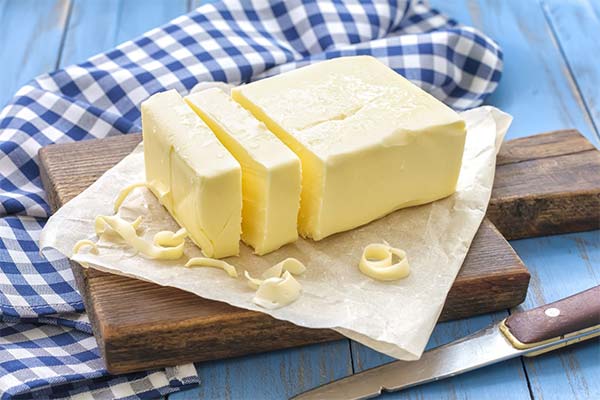
GOST or TU
The inscription on the packet "Made according to GOST" is not enough. You should pay attention to the marking of the standard.
There are two GOSTs for oil in our country:
- Interstate standard GOST R 32261-2013.
- National standard GOST R 52253-2004.
According to the first standard, only traditional, amateur and peasant types can be produced with the obligatory indication of the name "butter butter" on the package.
The second GOST applies to the production of tea and sandwich butter. Such a product is made exclusively from dairy fats and with a fat content of at least 50%.
But GOST R 32188-2013 means that the package contains margarine, despite all the assurances of the manufacturer. GOST R 52100-2003 is printed on spread and melted blends.
Excellent butter can be produced not only according to GOST, but also according to technical conditions (TU). If the manufacturer uses the formulation according to TU, then there must be an inscription with the letters "STR" or the following text - the product is produced "in accordance with the technical regulations". Quality butter must contain only whole milk or cream. Vegetable oils (most often sunflower, palm and coconut oils), which are often disguised as "milk fat substitutes", indicate a low-quality product, even if the manufacturer writes different information on the package.
Fat content
The fat content of butter ranges from 60 to 82.5%. Fat product has a higher calorie content and cost, but it has more benefits. Therefore, you should not economize to the detriment of your health. Depending on the fat content, there are varieties of butter: traditional butter with the highest fat content, amateur, peasant, sandwich and dietary tea butter.
Color
Real butter is an even, light yellow shade. A rich yellow color is a sure sign of dye added to the product. A whitish tone indicates the presence of vegetable fats in the composition. If the oil is stored uncovered, a transparent yellow film will form in the air. It is better to remove it, as it gives the oil a bitter taste. The same top layer can form if the butter has been exposed to direct sunlight for a long time.
In summer, when the cows are eating fresh grass, butter from milk turns out a richer color than in winter. In any case, the color should be uniform throughout the piece, with no colored streaks or flecks.
Smell
Real butter almost does not smell, so the presence of a bright milky smell will tell about the addition of flavorings. A foreign unpleasant odor appears when improperly stored.
Composition
In 100 grams of butter contains up to 82 g of fat, about 1 g of carbohydrates and proteins, the rest are water and organic acids.
Butter, which contains vegetable fats, can not be considered as creamy by right. All milk fat substitutes, flavor enhancers and emulsifiers, apart from their low calorie content, do more harm than good. Trans fats contained in spread or margarine disrupt metabolism, contribute to the development of atherosclerosis, cancer, cardiac diseases, and diabetes. The use of such products is extremely not recommended for pregnant and lactating women.
A good butter should contain cream or whole milk in the first place. On the label of a premium quality product created only from high-fat cream, there may be no composition as such. The manufacturer only indicates that "made from cream" or "from pasteurized cream." In addition, the label of a decent product should print the presence of table salt (for the salty kind) and concentrates of lactic acid organisms (if it is sour cream). Some manufacturers add the safe food coloring carotene (E 160). But if the composition is full of flavorings, preservatives, stabilizers and emulsifiers, you should not buy such oil. According to GOST the composition of peasant butter must include vitamins A, E and D, in an amount strictly corresponding to the norm.
According to the standard any other products made from milk can be added to butter. Most often whey is used, of which separation separates a certain amount of fat. Milk powder can also be seen in the composition.
Price .
Since it takes at least 20 liters of cream to produce 1 kg of butter, the cost of the final product cannot be low. Cheapness will be one of the indicators of low-quality goods.
Shelf life
To select a natural product, it is important to pay attention to the shelf life. On average, it is 30 days at 0-5 ° C and twice as much if frozen. It is better to defrost the butter on the refrigerator shelf rather than at room temperature. Repeated freezing of the product is contraindicated. Suspiciously long shelf life indicates the presence of preservatives.
Packaging
The most suitable packaging for butter is not paper or cardboard, but foil, which protects against the absorption of foreign odors and destructive sunlight.
Proper Butter Storage
To prevent a large piece of butter from becoming moldy, it is advisable to freeze it and break off small pieces as needed. The useful properties of the product do not change after defrosting. To avoid yellowing, unpleasant odor and moldiness, it is better to buy a ceramic or wooden oil can. It is better to put it on the top shelf of the refrigerator. It is not recommended to store in plastic bags or plastic containers, as oil easily adsorbs harmful substances.
If you don't have a refrigerator for some reason, you can keep the butter edible by putting it in an enamel pan with salted water, covering it with a plate and putting a weight on it. You need to find a cool place for the crock.
Real butter: hard or soft
The texture of butter depends on the ambient temperature. It has a low melting point of 30-36°C on average, close to human body temperature, which makes it easy to digest. At -18 ° C real butter hardens, on the refrigerator shelf retains a thick consistency, and on the kitchen table after a while it becomes soft. Counterfeit with vegetable additives defrosts very quickly, after which it is easy to spread on bread.
How to identify palm oil in butter
Palm oil is produced from the leaves and fruits of the oil palm. It appeared on the Russian market as part of food products relatively recently about 30 years ago. Due to its cheapness, it is still popular with unscrupulous manufacturers.
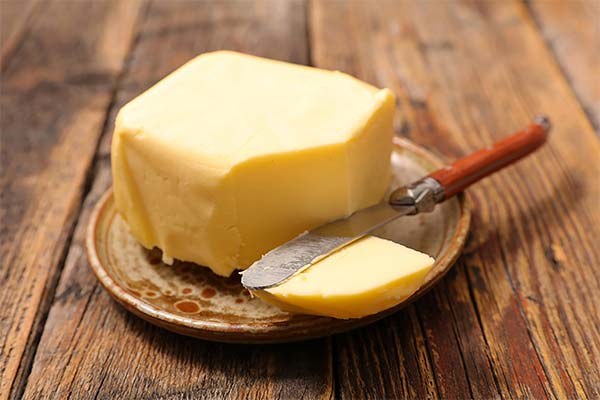
Palm fat is considered harmful to humans. It can not be absorbed by the body and begins to accumulate on the walls of blood vessels, provoking obesity, the development of cardiac diseases and cancer.
Palm oil can be found in many dairy products, and in confectionery products such as candies, cakes, cookies, etc. It increases the shelf life of products and improves taste.
Refined palm oil looks indistinguishable from margarine. If very little of it is added to butter, it is very difficult to tell by taste. The presence of palm oil can only be detected in the laboratory. When palm oil has replaced a significant amount of butter, a fatty film can be felt in the mouth after eating. Such butter sticks to your teeth and tongue.
You can also check for counterfeit butter by leaving a piece of the product on the table. Low-quality butter will melt unevenly, which is due to the higher melting point of palm fat. When heated to 37 ° C counterfeit product will not melt completely, you will see small solid specks.
Butter with vegetable additives will crumble and break when sliced, and moisture droplets will appear on the cut.
A product with a long shelf life should also be alert.
How to distinguish butter from margarine and spreads
Butter, spread and margarine look similar to each other, but they differ not only in price, but also in nutritional value. When you look closely, you can tell which product is in front of you, even if an unscrupulous manufacturer is trying to sell a low quality product at an inflated price.
Margarine is produced from natural and hydrogenated vegetable oils, mainly sunflower, rapeseed, soybean and others. Soft sandwich margarine and hard table margarine are available for sale. But as a substitute for peasant butter it is less and less common on the tables. It is most widely used in the preparation of baked goods. The main consumer of margarine is baking, confectionery and other industries.
In the finished product after processing of raw materials appears large amount of unsaturated fatty acids. They contribute to the destruction of the walls of blood vessels, causing cancer.
Margarine is hard to the touch and almost impossible to squeeze, even when pressed hard. It has a very faint odor. It may have milk powder, flavorings, whey, and coloring agents in its composition. The color of margarine is uniform, the cut is shiny and dry. Poor-quality raw materials will give off a bitter, sour or metallic taste. When heated over 200°C, margarine releases dangerous substances - aldehydes.
Spread literally means "that which is spread," but not butter. It is a fat product with a mass fraction of fat not less than 39%. It is made from milk fat with the addition of vegetable oils, so it is very pliable and easy to squeeze when pressed.
Spreads can be low-fat (39-49%), medium-fat (50-69%) and high-fat (70-95%). According to the content of milk fat are:
- Creamy and vegetable spread, where milk fat is at least half of the total fat content of the product.
- Vegetable and creamy spreads contain from 15 to 50% milk fat in relation to vegetable fat.
- The vegetable-fat product has less than 15% of animal fat. It is considered the most healthy of all kinds.
Fans of the right food, thinking about the figure and health, as well as people with atherosclerosis, diseases of the cardiovascular system, are increasingly choosing spreads. After all, the vegetable fats in its composition do not contain cholesterol at all, and it is also low-calorie. On the other hand, it is necessary to remember about the presence of trans fats in spread and not to abuse it.
The consistency of spreads is soft and homogeneous. The color of the product can be white or with a yellowish hue, and the surface is glossy. The taste is creamy but it does not have a pleasant aftertaste. Unlike natural butter, the edge of the product is crumbly when cut, and water droplets appear on it. After freezing the spread thaws quickly and is easy to spread on bread. The fat-and-milk product can be stored longer than normal butter.
Spread can be used in the preparation of various dishes, including baking. But it is not suitable for frying, because it does not melt in the pan, but burns.
How to determine the quality of butter at home
There are several ways to determine the quality of butter at home.
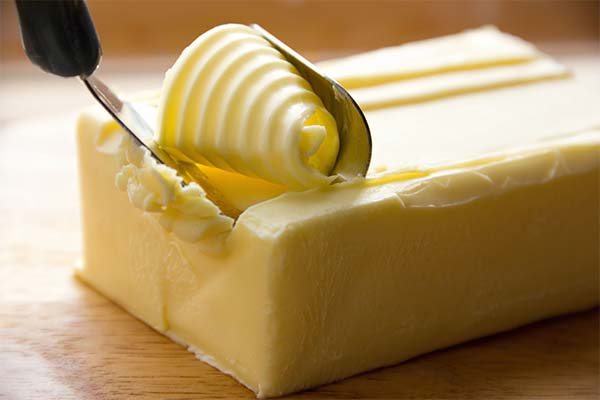
By the wrapper
Real creamy product will never stick to the package because of the high percentage of fat content, unlike counterfeit products.
By texture.
You can leave a small piece on a plate on the kitchen table. Quality butter should soften after an hour, but the shape will remain. The release of droplets of moisture and spreading will give away poor quality.
In a frying pan
When heated in a hot pan, good butter will melt gradually without releasing water or foam, spreading an appetizing smell. Margarine will sizzle and foam almost odorlessly. Food is likely to burn on it.
By cut.
The consistency of the butter should be tight, not crumbly when cut. The cut surface of good quality butter is even, uniform in color, and dry in appearance. The presence of small drops of moisture proves that it is already margarine or spread.
Using the freezer.
Real butter will freeze in an hour and will break off in chunks. If it has already melted and still crumbles when sliced, then either the butter has been repeatedly defrosted and frozen, or the production technology is broken. A product with vegetable fats, even after freezing, will be sliced evenly and remain soft.
How it tastes
The original product tastes creamy with a taste of pasteurized milk. Bitterness, acidity and other flavors should be alert. A piece of butter melts instantly on the tongue. Margarine sticks to the teeth and does not dissolve for a long time, leaving a fatty plaque.
By the knife.
When spread on bread, good butter is easy to apply and does not stick to the knife, unlike margarine or spread.
With hot water.
A piece of real butter will dissolve evenly in water, while spread will flake and precipitate after a while.
With the help of manganese.
If you put a piece of oil in a glass of manganese solution, the quality product will make the liquid lighten. A counterfeit will not affect the solution in any way.
How to choose quality oil in a store
Buying oil by weight, there is a great chance to run into a stale product, and for sanitary reasons it is better to buy it in an individual package. In order not to be disappointed with the choice of butter, trying it at home, you should carefully study the label of the product. The cost of real butter is of great importance. It is quite high, so it is important not to choose a fake.
First of all, you should pay attention to the name. On the package the word "butter" must necessarily be written, for example, "butter amateur", "butter cream", "peasant butter" or "cow's butter" with the indication of the grade. Calling it "real butter", "maslitse", "butter special", "extra" is only misleading and has nothing to do with a natural product. "Dairy product" or "spread" is definitely not butter.
The next thing to look at is the shelf life. A short shelf life indicates a natural product. Quality butter cannot be stored for more than a month. The longer the shelf life, the more likely the presence of preservatives or vegetable fats.
You should carefully read the composition of the product. The smaller the list of ingredients, the better.
To the touch, the packaging should be tight, without damage or dents. If a slight pressure leaves a noticeable depression, then most likely in the hands or margarine, or low-quality goods. You can smell the oil. It can not have a strong aroma without added flavorings. The presence of extraneous odors indicates improper storage and transportation, which will not affect its taste in the best way.
How to make butter at home
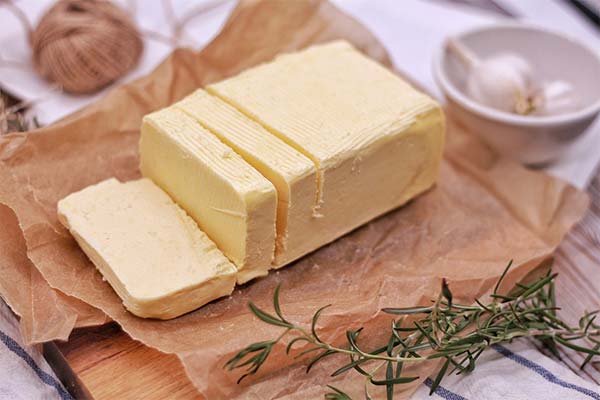
Real butter can also be made at home. You will need at least 6 liters of whole cow's milk. First you need to collect the cream. Put the milk in glass jars in a warm room for a couple of days. As a result, the milk will divide into sour milk and cream on top. They need to be collected in a separate deep bowl and cooled for a day.
From 1 liter of milk comes out about 80-100 ml of heavy cream. You should whip the cooled raw material with a mixer until it thickens.
When the mass becomes thick and unyielding, begin to stir with a wooden pusher for another 5 minutes counterclockwise. The resulting liquid should be drained, and the finished butter should be placed in the refrigerator or frozen.
«Important: All information on this site is provided solely for informational for informational purposes only. Before applying any recommendations, consult with a specialist. specialist before you use any of the recommendations. Neither the editors nor the authors are liable for any possible harm caused by materials."

